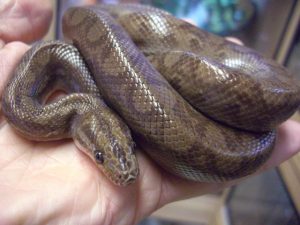Copyright 2021 Evolution Reptiles
All rights reserved.
Copyright 2025 Evolution Reptiles
All rights reserved.
All rights reserved.
The Columbian rainbow originates further north than its better known cousin, the Brazilian rainbow boa; it can be found across Columbia, Venezuela, and as far north as Costa Rica and Nicaragua. A medium sized constrictor, they rarely exceed 152cm (5 feet), often being significantly smaller than this. Males tend to be more slender than the females at around 120cm (4 feet), although they can reach the same size with good care.

Often regarded as the most docile and accommodating of the rainbow boas, the Columbian can make an excellent pet. Although as adults their markings fade and they become mostly brown, they retain the iridescence for which the family is named. This phenomenon is caused by structural colouration, often seen on bird’s feathers, and is due to microscopic ridges on the surface of the scale refracting light, like a prism. Most snakes have this iridescence to a greater or lesser degree, but it is especially well developed in the rainbow boas.
Although a mostly terrestrial snake, Columbians do like to climb and are often found in the lower branches of shrubs and small trees in the wild. It’s worth providing them with a little more headroom in their vivarium to allow for a good supply of sturdy climbing branches. Their vivarium should provide plenty of space for branches whilst still having a large floor area to permit normal activity; a wooden vivarium of at least 120 x 60 x 60cm (48 x 24 x 24”) is sufficient, but a bigger home might be necessary for a particularly large or active individual.
Like the majority of the rainbow boa species they are remarkably temperature sensitive; temperatures above 30ºC (86ºF) can be uncomfortable for them, and over 35ºC (95ºF) will cause distress, although they are somewhat hardier than some of the other species in the group. A daytime ambient temperature of between 25 and 30ºC suits them fine, with a temperature drop at night. Heat is best provided by a deep heat projector controlled with a suitable thermostat, monitored with a digital thermometer. Deep heat projectors should always be fitted with a guard, as a curious snake can get terrible burns by coming into contact with them.
They do appreciate a very high humidity, which can be difficult to maintain in a wooden vivarium with ceramic heaters; if the overall humidity is low, it is important to provide at least one wet hide filled with very damp moss where the snake can rest in a high humidity environment.
Whilst UV lighting is generally not considered essential for snakes, snakes do benefit greatly from it when it is offered. As a Ferguson Zone 2 species (occasional basker, thermoregulator) Columbian rainbows in the wild use dappled shade to control their temperature and UV exposure. Using a low output T5 strip light will help to recreate these conditions within the vivarium, and should be considered essential for this species.
As a partly arboreal snake, some Columbians will refuse to eat mice or rats and will prefer birds. If this is the case it is possible to wean them on to rodents by rubbing a defrosted chick on the intended food. A little perseverance pays off!
Although not as flashy as its close cousin, the Columbian rainbow boa nevertheless makes a beautiful, docile and interesting pet.
Copyright 2021 Evolution Reptiles
All rights reserved.